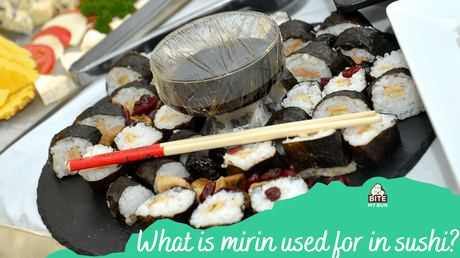When it comes to Japanese dishes, mirin is quite a prevalent ingredient. Almost all popular Japanese recipes use this alcoholic beverage to level up the flavor for typical dishes, especially in sauces.
Many people don’t know that sushi chefs also use them to enhance the taste of sushi rice.

Mirin helps a lot in making some types of sushi, especially sushi rolls. It is often used to add a pleasant sweetness to the sushi rice, with a bit of umami and acidity to enhance the flavor.
However, mirin is not always added because it will only work on certain types of sushi.
Are you curious about how mirin makes sushi better? Let’s learn more about mirin and how it improves your favorite sushi dish.
What is mirin?
You might have seen or heard mirin once or twice before, especially if you like watching Japanese food recipes.
Mirin is a Japanese rice wine with low alcohol content. To be precise, it has a 14% alcohol content, which is enough to get you drunk (just like wine.)
But mirin is usually seen in the kitchen and only used for cooking, not drinking.
What makes mirin a great kitchen staple is its sweetness and a little bit of acidic kick. It has a subtle richness or umami flavor that goes well with savory dishes.
Most cooks use this ingredient for soups, sauces, and stir fry. Some cooks use mirin for making sushi rice.
How is sushi rice made?
Sushi rice is flavored Japanese rice with vinegar and salt. When no vinegar is available, chefs will use citrus flavorings to get the sour, acidic taste.
In some sushi recipes, using sugar is also a common practice. Due to its mild acidity and sweetness, mirin is quite an essential part of some regional sushi dishes.
Also learn How to cook sushi rice without a rice cooker
Benefits of using mirin for sushi rice
Traditionally, sake (another type of Japanese alcohol) is used to give sushi its unique flavor. Sake has a property that enhances the aroma and flavor of the dish.
But these advantages are also apparent for mirin. In fact, people tend to enjoy mirin with soy sauce. Its mild sweetness is also a great addition to the mix.
In making sushi rice, mirin is the ingredient of choice if sweetness is of the essence in a recipe. The rice wine helps in elevating the flavor without stealing the spot from the sushi’s main ingredient.
Additionally, you can enhance the tanginess and acidity of the rice wine vinegar.
Take note: rice wine vinegar is not mirin. Mirin has sugar due to it being an alcoholic beverage. Meanwhile, rice wine vinegar is already in its acidic state, which is why it is sour and doesn’t have a sweetness to it.
And last but not least, mirin adds a bit more umami to the sushi rice. This imparts a deeper flavor, as well as a velvety texture to the final result.
Just make sure to not add a large quantity to your sushi rice, or it will be too sweet or too rich.
When can you use mirin for sushi?
Mirin is usually added to sweet sushi dishes, like barazushi (sushi with scattered nori and vegetables) and chirashizushi (similar to barazushi, but with regional various differences.)
Typically, sushi recipes with mirin have vegetables and lighter ingredients.
Adding sugar to your sushi rice is enough if you’re making a sweet sushi recipe. But mirin is a better option due to its additional layers of flavor and aroma improvements.
However, using it on any sushi recipe with raw fish is a bad idea. Nigiri sushi is better with sour and salty sushi rice.
Next, learn about the very important difference between aji mirin and hon mirin
